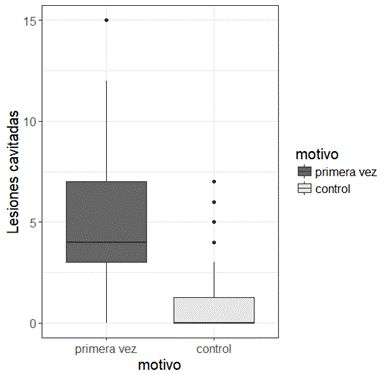Abstract
The Pediatric Dentistry Clinic at the School of Dentistry, Universidad de la República, has a care model that focuses on promotion, health education and rehabilitation, and aims to support health control and maintenance. There is no information on the impact of periodic checkups.
Objective: To evaluate the association between the number of checkups and oral health in children aged between 5 and 10. Cross-sectional, descriptive (2017-18) and retrospective (up to 2014) study in two subpopulations: G1 = checkups, and G2 = first visit. We evaluated the differences in the number of teeth affected.
Results: The sample included 115 children: 44 in G1 and 71 in G2. All of them had biofilm. G1 presented significantly lower values regarding visible plaque index (VPI) (>20%) (p < 0.001) and cavitated lesions (p < 0.001). G1 members, who had attended two or more checkups, had 2.6 initial lesions on average, and G2 members, 4.5 (p < 0.001).
Conclusions Children who had attended two or more checkups had better oral health than those seeking care for the first time. This confirms the importance of scheduled checkups for maintaining oral health.
References
Bordoni N, Escobar A, Castilla R. Capítulo 42. En: Odontología Pediátrica. La salud bucal del niño y del adolescente en el mundo actual. 1º Ed. Buenos Aires: Médica Panamericana, 2010. 881p.
Deep P. Screening for Common Oral Diseases. J Can Dent Assoc. 2000; 66:298-9.
Wange NJ, Holts D. Individualizing recall intervals in child dental care. Community Dentistry and Oral Epidemiology. 1995; 23 (1): 1-7.
Frame PS, Sawai R, Bowen WH, Meyerowitz C. Preventive dentistry: practitioners’ recommendations for low-risk patients compared with scientific evidence and practice guidelines. Am J of Prev Med. 2000; 18 (2): 159–62.
Scott G, Brodeur JM, Olivier M, Benigeri M. Parental factors associated with regular use of dental services by second-year secondary school students in Quebec. J Can Dent Assoc. 2002; 68 (10): 604–8.
Mettes D. Insufficient evidence to support or refute the need for 6-monthly dental check-ups. What is the optimal recall frequency between dental checks? Evid Based Dent. 2005; 6 (3): 62-3.
NICE Guidance. Dental Checks: intervals between oral health reviews. October 2004. Disponible en: https://www.nice.org.uk/guidance/cg19
Gibson C, Moosajee A. Selecting appropriate recall intervals for patients in general dental practice an audit project to categorize patients according to risk. Dental Update. 2008; 35 (3): 188-190, 193-194.
Bordoni N, Doño R, Miraschi C. Preconc. Organización Panamericana de la Salud 1992.
ICDAS Foundation. International Caries Detection and Assessment System. 2016. Disponible en: https:// icdas.org/downloads.
Ekstrand KR, Gimenez T, Ferreira FR, Mendes F, Braga M. The International Caries Detection and Assessment System- ICDAS. A systemic review. Caries Res. 2018; 52 (5): 406-419.
Ainamo J, Bay I. Problems and proposals for recording gingivitis and plaque. Int Dent J. 1975; 25 (4): 229-35.
The R Project for Statistical Computing (OR), A language and environment for statistical computing. R Foundation for Statistical Computing, Vienna, Austria. URL: https://www.R project.org/
American Academy of Pediatric Dentistry (AADP). Guideline on Periodicity of Examination, Preventive Dental Services, Anticipatory Guidance/Counseling, and Oral Treatment for Infants, Children, and Adolescents. 2013. Disponible en: http://www.aapd.org/media/Policies_Guidelines/G_Periodicity.pdf
Davenport C, Elley K, Salas C, Taylor-Weetman CL, Fry-Smith A, Bryan S, Taylor R. The clinic effectiveness and cost of routine dental checks. NIHR Health Technology Assessment program. health Technol Access 2003.
Disponible en: http://www.ncbi.nlm.nih.gov/pubmedhealth/PMH0015130/
Maltz M, Jardim JJ, Alves LS. Health promotion and dental caries. Braz Oral Res. 2010; 24 (Suppl 1): 18-25.
Walsh L J, Brostek A M. Minimum intervention dentistry principles and objectives. Aust Dent J. 2013; 58 (Suppl 1): 3–16
Maltz M, Andaló Tenuta LM, Groisman S, Cury JA. Cariología: Conceitos Básicos, Diagnóstico e Tratamento nao Restaurador. Publisher: 1era ed. Porto Alegre: Artes Medicas; 2016 144p.
US. Dept of Health and Human Services Healthy People 2010: midcourse review. Disponible en: http://www.healthypeople.gov/data/midcourse
Andrade y col. Epidemiología de las Enfermedades Periodontales en el Uruguay. Pasado y presente. Odontoestomatología. 2017; 19(30): 14-28
Tickle M, Williams M, Jenner T, Blinkhorn A. The effects of socioeconomic status and dental attendance on dental caries' experience, and treatment patterns in 5- year-old children. Br Dent J. 1999; 186 (3): 135-7.
Mejàre I, Källest l C, Stenlund H. Incidence and progression of approximal caries from 11 to 22 years of age in Sweden: A prospective radiographic study. Caries Res. 1999; 33 (2): 93-100.
Lith A, Lindstrand C, Gröndahl HG. Caries development in a young population managed by a restrictive attitude to radiography and operative intervention: II. A study at the surface level. Dentomaxillofac Radiol. 2002; 31(4): 232-9.
Abanto J, Celiberti P, Minatel M, Alvarez E, Cordeschi, Haddad A E, Bonecker M. Effectiveness of preventive program based on caries risk assessment and recall intervals on incidence and regression of initial caries lesions in children. Int J Paediatr Dent. 2015; 25(4): 291-9.
Clarkson JE, Pitts NB, Goulao B, Boyers D, Ramsay CR, Floate R, et al. Risk-based, 6-monthly and 24-monthly dental check-ups for adults: the INTERVAL three-arm RCT. Health Technol Assess 2020;24(60).
WHO 2021. Seventy-fourth World Health Assembly. EB148/SR/8. Mayo 2021. Disponible en: https://apps.who.int/gb/ebwha/pdf_files/EB148/B148_8-en.pdf

This work is licensed under a Creative Commons Attribution-NonCommercial 4.0 International License.


